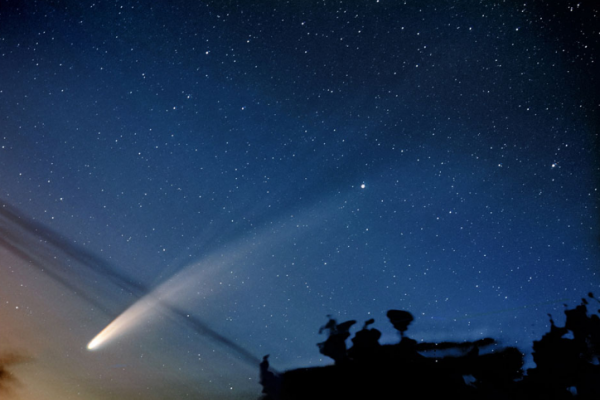Ohio SkyLites - August 2022

What’s Up? The Constellations, Planets, and Astronomical Events Visible in August 2022
Written and compiled by Alyssa Whalen
Sun
While the days on Earth are always 24 hours, the amount of sunlight we see in the northern hemisphere is growing smaller each day. The summer solstice is behind us, so until the winter solstice in December our time in the sun will continue to diminish. For astronomers, however, that gives us more time to observe the stars after the sun has set.
At the beginning of the month, on August 1st, the sun will rise at 6:30 am over Columbus, Ohio, and set at 8:45 pm. This gives 14 hours and 15 minutes of daylight. On the last day of the month, August 31st, the sun will rise at 6:58 am, and set at 8:04 pm, giving 13 hours and 6 minutes of daylight.
Moon
I know we just had a supermoon last month, but we get the opportunity to see another. The full moon this month will be the third and final supermoon of 2022: The Super Sturgeon Moon! The full moon will rise on August 12th, which is also when the moon is at perigee, the closest point to Earth in its orbit. This will cause the moon to appear much bigger and brighter in the night sky, giving it the title of ‘Supermoon.’ It is known as the Sturgeon Moon because North American fishing tribes found sturgeon in the great lakes during this month.
If you are looking for the right time to observe this month, try to go around August 27th. This is when there will be a new moon, so the sky will be much darker. Dark skies (and good weather) are the best time to see the fainter stars.
Planets
If you’re willing to pull an all-nighter, all 7 other planets are visible, just not at the same time. Venus will be best observed in the morning since it rises at 5:10 am before the sun. Mercury rises after the sun, so it would be easier to catch in the evening between sunset and 9:27 pm when Mercury sets.
The first planet to rise in the evening is Saturn around 8:23 pm followed by Neptune at 9:45 pm. Jupiter will rise later at 10:17, Uranus close to midnight, and Mars soon afterward at 12:30. Jupiter and Saturn are in perfect positions to be observed, and Mars should still be fairly clear; but you likely won’t see Neptune or Uranus without the assistance of a telescope.
Also occurring this month: Saturn is at its opposition point on August 14th. This means you could draw a straight line between the Sun, Earth, and Saturn. On August 27th. Mercury will be at its greatest eastern elongation. Greatest eastern elongation means that Mercury will be at its apparent furthest point behind the sun, so it will still be in the sky after the sun sets, making it easier to observe in the evenings. Planet rise/set times vary by day, so the times here are for August 15th as an ‘average’ for the month.
Constellations and Asterisms
The summertime is the perfect viewing time to observe the galactic plane and all the constellations around it. Sagittarius and Scorpius will be close to the horizon for most of the night, but near these constellations is where you will find the galactic center.
The ‘Teapot’ is an asterism within the constellation of Sagittarius. Asterisms are any shapes found in the stars. There are 88 officially recognized constellations, but there can be an infinite number of asterisms. Some popular asterisms are the teapot, and the big and little dippers.
If you look to the north, Ursa Major and Ursa Minor are still there to guide you to Polaris. These constellations will never set below the horizon (in latitudes as far north as Ohio), which is why they are fantastic stars to help you find your way in the sky.
The image below is a guide for the eastern horizon to the zenith at around midnight in mid-August
Other Notable Astronomical Events
While the Delta Aquarids Meteor Shower’s peak was in late July, shooting stars will still be visible until August 23rd in the constellation Aquarius. However, you get another chance to see a mass of shooting stars if you turn to the constellation Perseus. The Perseids Meteor Shower runs from mid-July to late August. It peaks on August 12th and fades around August 24th. This meteor shower, at its peak, can display up to 60 meteors per hour! However, the peak occurs around the August full moon, so the faint meteors will not be seen.
Now, go out and observe!
-- Alyssa
Sources
- https://www.timeanddate.com/astronomy/night/@5165418
- http://www.seasky.org/astronomy/astronomy-calendar-2022.html
- https://www.rmg.co.uk/stories/topics/what-are-names-full-moons-throughout-year
Image Credits
- http://alicesastroinfo.com/2007/01/mercury-at-greatest-elongation-2007/
- Full Sky Constellations credit to Stellarium
- Astro Bob cited from Earthsky https://earthsky.org/favorite-star-patterns/teapot-of-sagittarius-points-to-galactic-center/
